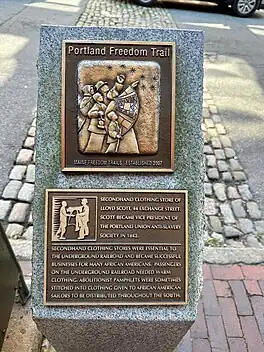| Portland Freedom Trail | |
|---|---|
 A marker of the Portland Freedom Trail on Exchange Street | |
| Length | 2 mi (3.2 km) |
| Location | Portland, Maine, U.S. |
| Established | 2007 |
| Use | Walking, history |
| Difficulty | Easy |
| Sights | 13 |
| Surface | Brick |
The Portland Freedom Trail is a self-guided walking tour of Portland, Maine. Established in 2007,[1] its 2-mile (3.2 km) course passes through the city's oldest and most historic areas, including those related to its African American population, and features thirteen points of interest. Most of the stops are in the Old Port and Arts District. The Abyssinian Meeting House, the third-oldest African American meetinghouse in the country, is a stop on the tour,[2] while several others are tied to the city's former Underground Railroad.[1][3]
Markers
The granite markers with bronze plates denoting points on the tour were designed and created by Daniel Minter, a contemporary artist in the city who was instrumental in creating the trail.[2] Some of the stops on the tour mark extant locations, while others mark former locations.[4]
Sights
The thirteen stops on the tour:[5]
- Franklin Street wharf, on Commercial Street, where enslaved people once arrived as stowaways on their journey to freedom[6]
- Barber Shop of Jacob C. Dickson, 243 Fore Street
- Hack Stand of Charles H. L. Pierre, 29 Middle Street
- Abyssinian Meeting House, 73 Newbury Street. The Abyssinian Meeting House was the first black congregation in Maine and a significant part of Maine's Underground Railroad network.[5]
- Home of Charles Frederick, Harriet Stephenson Eastman and Alexander Stephenson, corner of Mountfort and Newbury Streets
- Eastern Cemetery
- Home of Elias and Elizabeth Widgery Thomas, corner of India and Congress Streets
- Home of General Samuel C. Fessenden, 31 India Street
- Friends (Quaker) Meeting House, Lincoln Park, corner of Federal and Pearl Streets
- Hack stand of Reuben Ruby, corner of Federal and Temple Streets. Ruby was Portland's foremost African American Anti-Slavery activist and underground railroad conductor[7]
- First Parish Church, 425 Congress Street. The church was where an audience of 2,000 heard abolitionist William Lloyd Garrison speak in 1832. In 1842, a pro-slavery riot occurred at the church after abolitionist Stephen Symonds Foster spoke about New England's role in the institution of slavery.[5]
- Secondhand Clothing Store of Lloyd Scott, 44 Exchange Street
- Mariners' Church, corner of Fore and Moulton Streets, where there was an anti-slavery bookstore and a printshop run by Daniel Colesworthy. The print shop published Light and Truth From Ancient and Sacred History, by Robert Benjamin Lewis. The book was the first Afro-centric history printed in the U.S.[8]
See also
References
- 1 2 Kelley, Michael (February 24, 2021). "Virtual Portland walk points out city's early ties to slavery". Press Herald. Retrieved September 1, 2023.
- 1 2 "Portland Freedom Trail - Visit Maine". visitmaine.com. Retrieved September 1, 2023.
- ↑ Hood, Miles (March 28, 2023). "Local groups look to uncover Portland's role in the Underground Railroad". WMTW. Retrieved September 1, 2023.
- ↑ Writer, Bob KeyesStaff (July 12, 2020). "New exhibition, old sites tell Maine's Black history". Press Herald. Retrieved November 21, 2023.
- 1 2 3 Portland Freedom Trail – Maine Historical Society
- ↑ Press, USM Free (October 3, 2018). "The Portland Freedom Trail". The Free Press. Retrieved November 24, 2023.
- ↑ "Hack Stand of Reuben Ruby Historical Marker". www.hmdb.org. Retrieved November 24, 2023.
- ↑ "Mariner's Church Historical Marker". www.hmdb.org. Retrieved November 24, 2023.
External links
- Portland Freedom Trail self guided walking tour- Maine Historical Society
- "Portland Freedom Trail" – VisitMaine